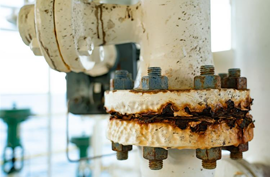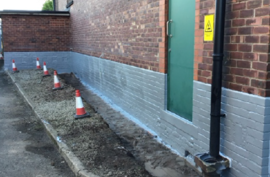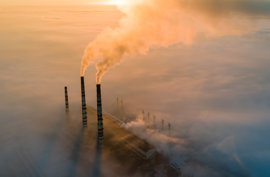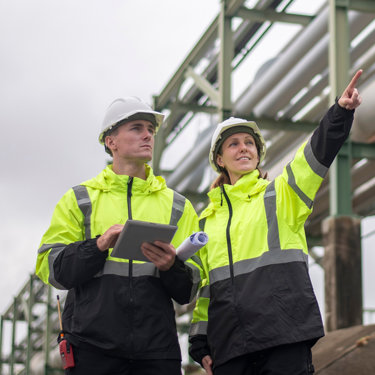Health and safety considerations of confined space entry for cleaning storage tanks
Published: 4 April 2022
By: Wayne Bergin, Tank Cleaning Manager
A regular tank cleaning regime cuts cross-contamination risks, safeguards key components and detects structural issues that could trigger catastrophic leaks and spills.
Without stringent health and safety protocols, however, the processes that extend your tank’s working life could pose significant danger to the specialists undertaking the clean.
Back to basics – what is a confined space?
The Health and Safety Executive (HSE) defines a confined space as ‘a place which is substantially enclosed (though not always entirely), and where serious injury can occur from hazardous substances or conditions within the space or nearby’.
Confined spaces generally fall into two categories: non-permit and permit.
Non-permit spaces
While non-permit spaces still pose threats linked to restricted entry and exit routes, they can be more readily accessed by workers and are free of the more acute dangers that define permit spaces.
Permit spaces
Permit spaces present additional risks, ranging from hazardous atmospheres and asphyxiation dangers, to the presence of liquids and free-flowing solids that could engulf occupants.
Before access can be granted to a permit confined space, site operators or an appointed qualified person must complete a formal safety checklist, called a permit.
Shared across the entire project team, the permit is a comprehensive planning document that defines the steps required to achieve safe entry conditions. It also outlines the health, safety and procedural elements of the task, including personnel, equipment and emergency protocols.
The HSE recommends that any permit should:
- Identify who can authorise particular jobs (and any limits to their authority)
- Name the person in charge of specifying necessary precautions, such as isolation, air testing and emergency arrangements
- Be clearly communicated to all contractors engaged to carry out work
- Only be issued by individuals with the proper training and instruction
- Be monitored and audited to ensure the permit system is fit for purpose
Large-capacity oil tanks, alternative fuel tanks, foul tanks and storage facilities for chemicals, water and any other liquid or gas are typically classed as permit spaces that demand specialist support to access and maintain.
Understanding the hazards of tank cleaning
Every year in the UK, people are killed or suffer life-changing injuries within confined spaces, including those who attempt rescue operations without the necessary knowledge or equipment.
Working in confined spaces produces a catalogue of common risks, running from oxygen deficiency and poisonous vapours, to sources of ignition and suffocation threats.
Tank cleaning operators face new pitfalls with every project, depending on the structure, size, contents, and condition of the tank.
The presence of toxic substances could bring about short-term complications, including dizziness, eye irritation, headache, and nausea – or cause career-limiting health issues, such as occupational asthma.
Other dangers of internal tank cleaning and inspection include:
- Flammable materials and atmospheres
- Bacterial infections from contaminated water and sludge
- Entrapment and trip hazards
- Ignition, explosion and fire threats from sparking equipment, lightning, and excess oxygen
- Falls from height
- Exposure to harmful chemicals
- Loss of consciousness caused by an increase in body temperature
Engaging a tank cleaning and inspection expert will not only deliver the most effective and beneficial solution, but also ensure operators do their job in dependably compliant conditions.
The letter of the law – what are your legal requirements?
Under the Management of Health and Safety at Work Regulations 1999, business owners and self-employed people are required to conduct ‘a suitable and sufficient’ risk assessment for all work activities. This assessment defines the measures needed to make the task safe. For work in confined spaces, this means identifying and evaluating the hazards, and mapping out preventative actions to address them.
When a risk assessment pinpoints the potential of serious injury, the Confined Spaces Regulations 1997 come into force.
First and foremost, the regulations advise employers to seek out methods that allow the job to be completed outside the space.
If entry is deemed unavoidable, safe systems of work must be followed and an appropriate rescue and response plan must be in place before any activity begins. This involves anticipating any possible emergencies and ensuring recovery equipment and appropriately trained personnel remain on standby for the duration of the process.
Cutting the risks of confined space work
In line with the Confined Spaces Regulations, employers first have a responsibility to explore non-entry alternatives, either by modifying working practices or the space itself.
In the case of tank cleaning and inspection, recommended approaches include gamma jetting, 360° cleaning heads and state-of-the-art robotic systems. When performed by experienced specialists, these techniques achieve a pristine, top-to-bottom result, however inaccessible the location and whatever the type, material, and capacity of the tank.
Similarly, experts can remotely identify degradation, corrosion, and structural defects via non-destructive testing (NDT) – a cutting-edge, cost-effective means of assessing the condition of storage tanks, pipelines and wells from a safe distance. Widely used across the bulk storage, refinery, fuel/petrochemicals, chemical and utility sectors, NDT uses top-tier fibre optic technology to access restricted spaces, scale tank walls and thoroughly survey all internal components to ensure compliance with current regulations.
When non-entry strategies simply aren’t an option, every possible step should be taken to mitigate hazards. Once a full risk assessment, permit-to-work process, staff training and emergency response plan have been established, every team member needs the right tools for the job – from correct PPE and certified equipment, to tried-and-tested lifting gear, safety harnesses and breathing apparatus.
The ‘toolbox’ extends to the supervisory team too. Confined space entry boards can be used by onsite support workers to track personnel inside the space, limit working time, record key information and strictly control entry and exit activity.
The inside job – what happens during a tank clean and inspection?
Qualified tank cleaning crews are engaged for a variety of reasons, either as part of an ongoing maintenance programme or to tackle specialist assignments, such as changing the stored product, decommissioning, transportation or assessing contamination or damage.
Every operation should start with a site visit to discuss individual requirements and inspect underground, ground-level or above-ground systems. The ‘scoping out’ phase should also include permit and planning work, certification, and practical recommendations of the safest, most economical methods of access, gas purging, clean-up and inspection.
A highly trained team will then employ the appropriate cleaning tools and techniques to transform the condition of the tank. This could encompass hot-water washing, cold-water spray, ultra-high-pressure jetting, shot blasting, specialist chemical cleaning or manual wiping to remove rust, sludge and surface dirt from the tank’s walls, floor, and fittings.
As part of a complete end-to-end service, general tank health and structural integrity are assessed via pressure testing, identifying deterioration and potential leak and spill hazards.
Fuel polishing specialists can also eliminate invasive water, free water sediment and microbial contamination.
Tanks are then restored to full operational order and waste is efficiently transported and treated for compliant disposal.
No two jobs are the same – safeguarding staff through training and certification
Every tank clean and inspection presents unique hazards, so experts must remain agile in their approach.
This means not only preparing for the obvious red flags of a restricted area, but additional dangers created by the work itself – for example, chemical cleaning products that produce noxious or flammable fumes or hot-running equipment that raises the temperature of the space.
A rigorous commitment to staff training and certification ensures that tank technicians are prepared to protect themselves – and your assets – in any eventuality.
Key sector credentials include EEMUA 159 accreditation, confined space entry qualifications and OFTEC OFT/600A registration for oil tank and pipe work specialists.
Covering compliance from every angle – PPE and safety exercises
Confined spaces such as terminal storage tanks are highly dangerous working environments – and the correct health and safety protocols can make a life-or-death difference.
If a risk assessment calls for the use of personal protective equipment (PPE), it should always be viewed as the last line of defence, with safe systems of work providing primary protection.
Depending on the hazards identified, PPE could include safety lines and harnesses, protective footwear and clothing, calibrated oxygen detectors and either self-contained or constant flow airline breathing apparatus.
Recurring and varied drills ensure every member of the project team understands their safety duties, both during general work and in an emergency.
The HSE advise planning and practising your response to incidents linked to specific hazards, as well as accidents that involve retrieving individuals from within the confined space, such as falls or entrapment. Frequent training exercises help to seamlessly weave precise recovery procedures and the safe use of rescue equipment into standard working practices.
A ‘safety first’ mindset
Routine cleaning and inspection is a critical part of any tank maintenance strategy – but letter-perfect safety practices should always be your starting point.
Working with a qualified specialist will not only protect your investment and prolong tank performance, but also safeguard the confined space workers entering your tanks to deliver a five-star service.
More from our Knowledge Hub
 Insights
InsightsMitigating climate change risks through planned preventive maintenance
 Insights
InsightsProtective coatings: Safeguarding infrastructure against climate change
 Insights
InsightsDelivering the Water (Special Measures) Act: Supporting compliance and innovation
 Insights
InsightsA guide to navigating climate change regulations for UK businesses
Environmental compliance today, creating a sustainable tomorrow
Helping you reduce risk to the environment and your operation by managing assets compliantly while achieving commercial, ESG, and net-zero goals.
Contact our experts

